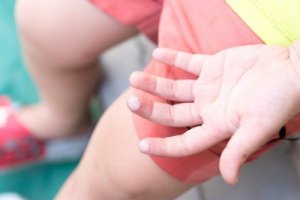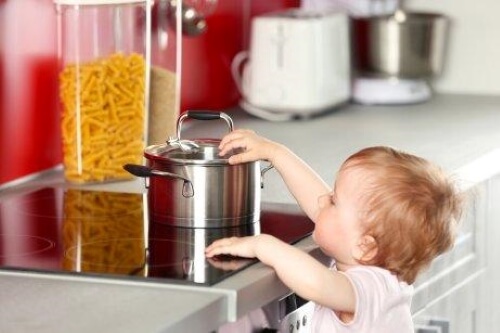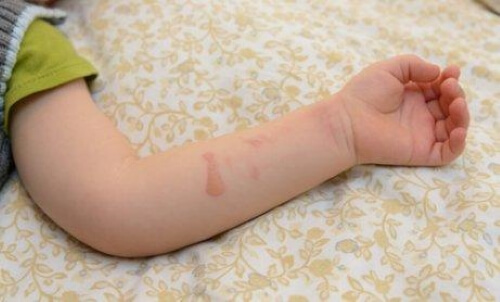How to Treat Blisters in Children

By following a simple plan of action for how to treat blisters in children, you will have peace of mind knowing you’re taking good care of them and helping to heal their blisters as quickly as possible.
Children often get lesions on the skin called blisters that look like tiny pockets of liquid or bubbles on the skin. They can be bothersome and sore. Luckily, in most cases, they’re no cause for alarm.
What are blisters and why do they appear?
A blister is a pocket of water that appears in the upper layers of the skin as a result of friction, allergies, or burns. They aren’t dangerous in most cases; they tend to be small and they’re filled with a clean, transparent liquid. This wound appears in the top layer of skin and they get better on their own if they’re left alone.
At times, however, these bothersome bubbles are larger and appear where there’s a lot of friction from rubbing on the skin. In these cases, the blister often breaks. For example, children can get blisters when they wear shoes that are too tight.
Blisters can also appear if you suffer a severe burn from a hot liquid or exposure to some chemical product as well as from too much exposure to the sun. Other causes are due to freezing, eczema, allergic reactions, and viral infections like varicella zoster.
How do you treat blisters in children?
First, it’s important to prevent the blister from getting infected. You should act quickly to clean the wound especially if the blister breaks.
People say conflicting things when it comes to treating blisters. There are those who believe you need to take out the liquid to give some relief to the skin and to avoid further damage. Others say the opposite.
When faced with blisters, you can take the top layer of skin off with a pair of rounded scissors that have been disinfected with alcohol. This won’t be painful for the child.
Afterward, parents or caregivers should help wash the wound with saline which will clean it thoroughly and help the skin to regenerate adequately.
On the other hand, if you don’t want to take the top layer of skin off the blister, you can disinfect the surface very well with saline. In both cases, it’s recommended that you cover the blister with gauze or an adhesive bandage to avoid more friction.

If the blister becomes infected, which will be obvious if you see a lot of redness in the affected area, it’s best to apply an antibiotic ointment. If the wound still doesn’t look better in one or two days, you should go to the doctor.
When children have blisters, it’s necessary that the parents keep an eye on the wound to assure it’s healing properly. Normally, blisters heal themselves after several says. The skin breaks and they dry up and fall off. This is the normal trajectory for this kind of wound.
Home remedies for blisters
Many times, grandma’s advice works best and effectively treats your children’s blisters. There are many home remedies said to help heal these bothersome little lesions.
Some of these cures are listed below:
Salt and water
It’s enough to rinse the affected area with a little warm water and salt. This helps to clean the wound and prevent possible infection. At the same time, it stimulates circulation and speeds up the renovation process of the skin.
How to treat blisters: garlic
Families have used this wild plant for medicinal purposes for many centuries because it has antibacterial properties and it’s an effective cellular activator. To apply it to a blister, you have to rub a peeled clove on the affected area.
“It’s necessary that the parents are highly vigilant on how the blister evolves. Normally they heal in a few days by themselves.”
Aloe vera
Aloe vera is one of the most effective and recommended natural remedies because of its ability to heal scars. It easily penetrates into the skin and its hydrating properties speed up healing and reduce inflammation.
Apple cider vinegar
You can use apple cider vinegar as an antibiotic and for its healing properties. It effectively cleans wounds and eliminates bacteria due to the acetic acid it contains; this gives it antiseptic power, which helps to prevent infection in blisters.
Before applying it on the wound, it’s necessary to dilute the apple cider vinegar with water to avoid irritation.

How to treat blisters: corn starch
This can be useful if the blister has broken. With this common kitchen ingredient, it’s possible to make a really effective salve.
To do this, you should dose out one tablespoon of cornstarch and one tablespoon of honey in a clean receptacle. Mix both ingredients to make a paste and apply it to the affected area.
Although all these ways of treating blisters are useful, it’s always better to try to prevent any injuries in the first place. We should try to quickly figure out what caused the blister and take measures so it doesn’t happen again.
Finally, remember that these alternative home remedies will help you to easily treat blisters in children if you find there’s nothing in your first aid kit that is suitable for treating this kind of lesion.
If you soon note there is no improvement in the blister, it could be that you’re facing something more complex. In this case, you should certainly see a doctor. Never self-treat your children.
By following a simple plan of action for how to treat blisters in children, you will have peace of mind knowing you’re taking good care of them and helping to heal their blisters as quickly as possible.
Children often get lesions on the skin called blisters that look like tiny pockets of liquid or bubbles on the skin. They can be bothersome and sore. Luckily, in most cases, they’re no cause for alarm.
What are blisters and why do they appear?
A blister is a pocket of water that appears in the upper layers of the skin as a result of friction, allergies, or burns. They aren’t dangerous in most cases; they tend to be small and they’re filled with a clean, transparent liquid. This wound appears in the top layer of skin and they get better on their own if they’re left alone.
At times, however, these bothersome bubbles are larger and appear where there’s a lot of friction from rubbing on the skin. In these cases, the blister often breaks. For example, children can get blisters when they wear shoes that are too tight.
Blisters can also appear if you suffer a severe burn from a hot liquid or exposure to some chemical product as well as from too much exposure to the sun. Other causes are due to freezing, eczema, allergic reactions, and viral infections like varicella zoster.
How do you treat blisters in children?
First, it’s important to prevent the blister from getting infected. You should act quickly to clean the wound especially if the blister breaks.
People say conflicting things when it comes to treating blisters. There are those who believe you need to take out the liquid to give some relief to the skin and to avoid further damage. Others say the opposite.
When faced with blisters, you can take the top layer of skin off with a pair of rounded scissors that have been disinfected with alcohol. This won’t be painful for the child.
Afterward, parents or caregivers should help wash the wound with saline which will clean it thoroughly and help the skin to regenerate adequately.
On the other hand, if you don’t want to take the top layer of skin off the blister, you can disinfect the surface very well with saline. In both cases, it’s recommended that you cover the blister with gauze or an adhesive bandage to avoid more friction.

If the blister becomes infected, which will be obvious if you see a lot of redness in the affected area, it’s best to apply an antibiotic ointment. If the wound still doesn’t look better in one or two days, you should go to the doctor.
When children have blisters, it’s necessary that the parents keep an eye on the wound to assure it’s healing properly. Normally, blisters heal themselves after several says. The skin breaks and they dry up and fall off. This is the normal trajectory for this kind of wound.
Home remedies for blisters
Many times, grandma’s advice works best and effectively treats your children’s blisters. There are many home remedies said to help heal these bothersome little lesions.
Some of these cures are listed below:
Salt and water
It’s enough to rinse the affected area with a little warm water and salt. This helps to clean the wound and prevent possible infection. At the same time, it stimulates circulation and speeds up the renovation process of the skin.
How to treat blisters: garlic
Families have used this wild plant for medicinal purposes for many centuries because it has antibacterial properties and it’s an effective cellular activator. To apply it to a blister, you have to rub a peeled clove on the affected area.
“It’s necessary that the parents are highly vigilant on how the blister evolves. Normally they heal in a few days by themselves.”
Aloe vera
Aloe vera is one of the most effective and recommended natural remedies because of its ability to heal scars. It easily penetrates into the skin and its hydrating properties speed up healing and reduce inflammation.
Apple cider vinegar
You can use apple cider vinegar as an antibiotic and for its healing properties. It effectively cleans wounds and eliminates bacteria due to the acetic acid it contains; this gives it antiseptic power, which helps to prevent infection in blisters.
Before applying it on the wound, it’s necessary to dilute the apple cider vinegar with water to avoid irritation.

How to treat blisters: corn starch
This can be useful if the blister has broken. With this common kitchen ingredient, it’s possible to make a really effective salve.
To do this, you should dose out one tablespoon of cornstarch and one tablespoon of honey in a clean receptacle. Mix both ingredients to make a paste and apply it to the affected area.
Although all these ways of treating blisters are useful, it’s always better to try to prevent any injuries in the first place. We should try to quickly figure out what caused the blister and take measures so it doesn’t happen again.
Finally, remember that these alternative home remedies will help you to easily treat blisters in children if you find there’s nothing in your first aid kit that is suitable for treating this kind of lesion.
If you soon note there is no improvement in the blister, it could be that you’re facing something more complex. In this case, you should certainly see a doctor. Never self-treat your children.
This text is provided for informational purposes only and does not replace consultation with a professional. If in doubt, consult your specialist.








